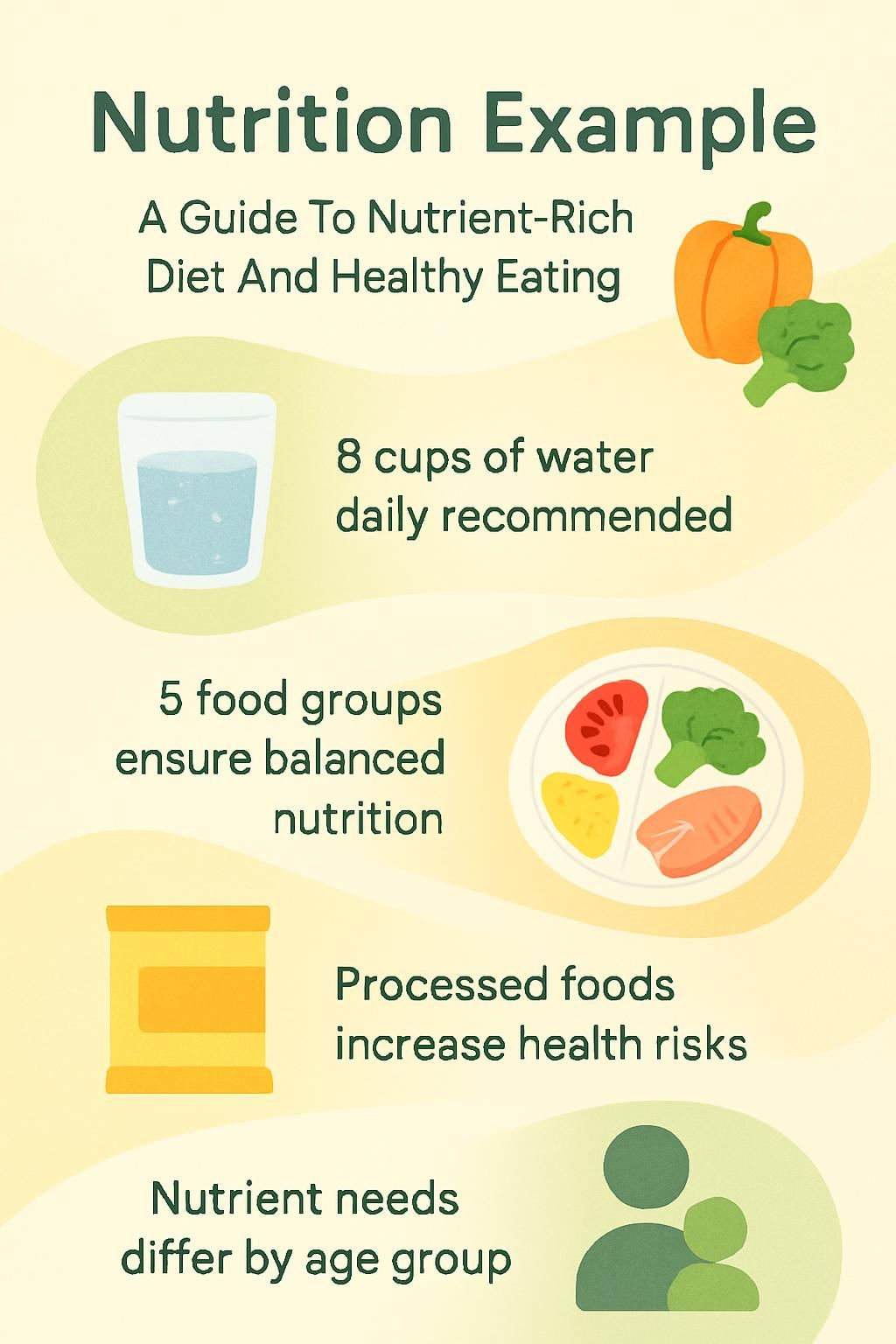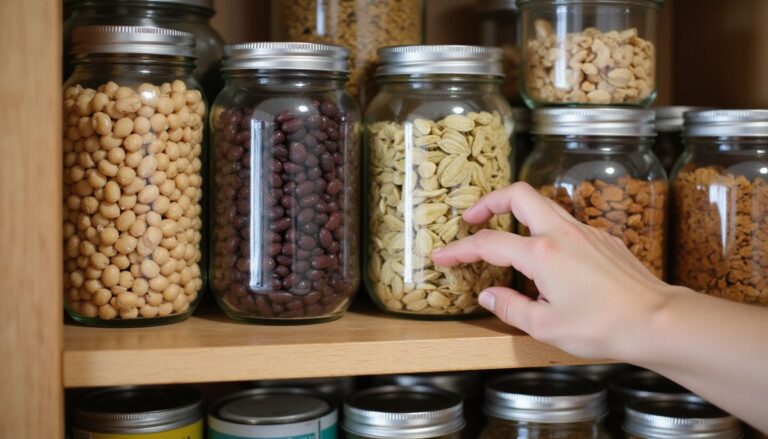Nutrition Example: A Guide To Nutrient-Rich Diet And Healthy Eating
Our Nutrition Assistant AI Suite will transform your body. You will lose fat, get toned, and build muscle. Gain confidence and optimal health.
You might feel unsure about which foods support your health or how to plan a balanced diet. Nutrition means choosing foods that supply energy and the right nutrients so your body can work well. Healthy eating starts with simple steps like reading a nutrition facts label, planning balanced meals, and keeping water close by.
In this Nutrition Example guide, you will learn how to include essential nutrients, scan labels with confidence, and build smart habits you can keep. Keep reading for practical tips that fit real life.
Key Takeaways
- Balanced meals from all five food groups meet needs for macronutrients and micronutrients and support healthy growth, weight, and disease prevention (USDA Dietary Guidelines 2020).
- Choosing whole grains, lean proteins, fruits, vegetables, and healthy fats links to lower rates of heart disease, diabetes, obesity, and stroke (CDC 2021).
- Water is essential for life. A common target is about eight cups daily, with needs varying by size and activity (Mayo Clinic 2022).
- Nutrient needs change with age. Kids need iron and calcium for growth; older adults benefit from nutrient-dense foods due to appetite or absorption changes.
- Limiting highly processed foods high in added sugars, sodium, and saturated fat supports weight control and heart health (American Heart Association 2022).

What is nutrition and why does it matter?

Nutrition is how your body takes in food, breaks it down, and uses the nutrients. Good nutrition can lower disease risk and help you maintain a healthy body weight.
What does nutrition mean?
Nutrition covers the way your body turns the food you eat and drink into energy and building blocks. You need macronutrients, which are carbohydrates, proteins, and fats. You also need micronutrients, which are vitamins and minerals. These support growth, skin and bone health, and your heart and blood vessels.
Water is vital too. Every cell relies on it.
You practice nutrition each time you choose foods from all five food groups, fruits, vegetables, grains, protein foods like beans or meat, and dairy such as milk or yogurt.
Eating fiber, vitamins like C and D, and omega-3 fatty acids from fish or walnuts supports healthy weight and lowers the risk of heart disease, high blood pressure, diabetes, obesity, and some cancers.
When I played soccer after school, meals with enough protein helped my muscles recover faster. I had better energy at the next practice.
Why is nutrition important for overall health?
Balanced meals give your body steady energy and key nutrients. Whole grains, lean proteins, fruits, and vegetables help your organs, muscles, and bones do their jobs each day.
Research shows that healthy eating patterns lower the chance of heart disease, diabetes, stroke, and high blood pressure. After illness or surgery, nutrient-rich foods help repair tissue and support the gut. Some nutrients also link to mood and brain function.
Limiting saturated fat and trans fat can improve blood cholesterol numbers. Cutting excess sugar and sodium helps control blood pressure and protects your heart over time.
Healthy eating shapes how you feel today and builds the base for lifelong well-being.
Essential nutrients your body requires
Your body relies on a mix of nutrients to build and maintain tissues and organs. Eating a nutrient-rich diet keeps your food and nutrition in balance and can lower disease risk.
What are macronutrients: carbohydrates, proteins, and fats?
Macronutrients are the nutrients you need in larger amounts. They fuel your body, support growth, and help organs function.
- Carbohydrates are the main source of energy, providing 4 calories per gram. You get them from foods like bread, rice, corn, barley, and fruit.
- Simple carbohydrates, such as glucose and fructose in juice or table sugar, digest fast and can spike blood sugar if you eat too much.
- Complex carbohydrates, like starch and fiber in whole grains, vegetables, and legumes, release energy slowly for longer activity.
- Proteins repair and build muscle and help regulate hormones. You can get them from animal foods like meat and eggs, and from plants like beans, soy, nuts, and seeds.
- Every cell uses protein to form new tissue and heal after injuries.
- Fats provide 9 calories per gram, so they hold more energy than carbs or protein. Sources include olive and vegetable oils, canola oil, butter, and margarine.
- Some fats help you absorb vitamins A, D, E, and K. High-density lipoprotein, or HDL, supports heart health by helping clear cholesterol.
- Choosing liquid oils instead of solid fats can reduce LDL cholesterol, which lowers the risk of high blood pressure and stroke.
- Guidelines from the United States Department of Agriculture encourage eating the right amount of each macronutrient to support a healthy body weight.
- Cells use these nutrients during metabolism, the process that turns food into energy your body can use.
What are micronutrients: vitamins and minerals?
Micronutrients are vitamins and minerals your body needs in small amounts. They are essential for many processes and you feel the effects when they are missing.
- Vitamins support immunity, metabolism, vision, and growth. Vitamin A aids vision, while B vitamins help turn food into energy.
- Minerals such as calcium support strong bones, the heartbeat, muscles, and nerve signals.
- Iron helps make hemoglobin in red blood cells. Low iron can cause anemia, which brings tiredness and weakness.
- Potassium supports healthy blood pressure and muscle function, including your heart.
- You need only small amounts each day, yet low intake can cause health problems or deficiencies.
- Children under five face higher risk of iron-deficiency anemia if their diet lacks iron-rich foods or supplements.
- Health and Human Services encourages getting micronutrients from whole foods, like leafy greens, nuts and seeds, lean meats, dairy for calcium, and fruit for vitamin C.
- Supplements may help some people, but they do not replace a diet rich in whole foods.
- Water-soluble vitamins, such as C and the B group, exit in urine. You need them often to avoid running low.
- Poor intake or imbalances can raise the risk of heart disease and other health issues over time.
Why is water essential for a healthy diet?
Your cells, tissues, and organs depend on water. You lose fluids through urine, sweat, and even breathing. Hot weather, larger body size, and exercise increase fluid loss.
Drink water daily and eat foods with high water content, like fruit and vegetables. Many adults aim for about 8 cups per day, but needs vary.
Dehydration can cause fatigue and dizziness. Severe dehydration harms the heart and other organs.
During summer sports, I felt shaky when I skipped water. Drinking more during the day helped my energy and focus.
Staying hydrated supports digestion and temperature control. It works hand in hand with macronutrients to keep you healthy.
The role of macronutrients in your body
Macronutrients power your day, rebuild tissue, and protect organs. Think of them as your body’s core tools.
How do carbohydrates provide energy?
Your body turns carbohydrates into glucose, a simple sugar. Glucose travels in your blood to fuel cells and organs.
Whole grains, starchy vegetables, and beans have complex carbs that digest slowly. That gives you steady energy. Sugary foods raise blood sugar quickly, then often drop it fast.
The glycemic index, or GI, shows how foods affect blood sugar. White bread scores high, while oats and nuts score lower. Oatmeal keeps me energized longer than sweet cereal before a morning run.
Carbohydrates add calories, but choosing high-fiber sources supports healthy eating and weight control.
How do proteins build and repair tissues?
Proteins supply amino acids, the building blocks your body uses to build and repair tissue. Your body does not store protein like it stores fat, so you need some daily.
Animal proteins like chicken, fish, eggs, milk, and lean beef are complete, meaning they provide all essential amino acids. Plant proteins often need combinations, such as rice with beans, to cover your needs.
Protein supports muscles, bones, skin, organs, blood vessels, and hair. Meeting your protein needs helps you recover from workouts and everyday wear and tear.
What role do fats play in energy and vitamin absorption?
Fats provide a dense form of energy. Each gram gives 9 calories, more than double carbohydrates or protein.
Monounsaturated fats, found in avocados, olive oil, and nuts, can reduce LDL cholesterol when they replace saturated fat. Polyunsaturated fats support cell health. Omega-6s are in corn and soybean oils. Omega-3s are in walnuts, flaxseed, canola oil, and fish.
Fat helps your body absorb vitamins A, D, E, and K. Without enough fat in a meal, these vitamins do not move well from the gut into your blood.
Regular use of butter and full-fat dairy adds saturated fat, which can raise LDL cholesterol. I switched to olive oil on toast and saw my LDL drop at my next checkup.
Choose nuts, seeds, and seafood to get healthy fats for energy and better vitamin absorption.
Important micronutrients for good health
Vitamins and minerals work behind the scenes to keep cells and organs running smoothly.
What roles do vitamins like Vitamin C and D play?
Vitamin C helps repair tissue, heal wounds, and support skin and immune health. It also acts as an antioxidant that protects cells from damage. Oranges, strawberries, and bell peppers are strong sources.
Vitamin D helps your body absorb calcium and supports bones, brain function, and immunity. Your skin makes vitamin D from sunlight. You can also get it from fortified milk and certain seafood.
These vitamins work with minerals like calcium to support bones and overall health in kids and adults.
Why are minerals like iron, calcium, and potassium important?
Iron helps your blood carry oxygen to every cell. Low iron makes you feel weak or tired because your organs do not get enough oxygen.
Calcium builds and maintains bones and teeth, and also supports muscle contraction and heart rhythm.
Potassium helps nerves work and balances fluid in cells, which supports healthy blood pressure. People who eat potassium-rich foods often have better heart health.
I had fewer leg cramps after adding bananas and leafy greens to my meals. Magnesium supports muscle protein building and energy production. Zinc supports vision and immune function.
Eating a wide range of whole foods supplies these minerals plus many other helpful nutrients.
References:
1) American Heart Association – Potassium & Blood Pressure (2022)
2) National Institutes of Health – Magnesium Fact Sheet (2023)
3) Harvard T.H. Chan School of Public Health – Zinc (2021)
How do nutrition needs change with age?
Nutrient needs shift across life stages. Your body asks for different support at each step.
What are the nutrition needs for children and teenagers?
Kids and teens grow fast, so they need balanced meals that cover all food groups.
- Infants meet most needs through breast milk or formula until 6 months. Introduce solids at about 6 months with a pediatrician’s guidance.
- For children and toddlers, include fruits, vegetables, grains, proteins like fish or lean meat, and dairy foods at meals.
- Teens often need more calories due to growth spurts. Active teens may need up to 2,800 calories a day depending on age, sex, and activity.
- Iron supports muscle and red blood cell growth. Offer lean meats, beans, and fortified cereals.
- Calcium builds strong bones during peak growth years. Choose milk, yogurt, cheese, fortified plant drinks, and leafy greens.
- Vitamin D aids calcium absorption and immunity. Get it from eggs, fatty fish like salmon, fortified foods, and safe sunlight.
- Keep water handy since active kids dehydrate quickly. Serve water more often than sugary drinks.
- Limit added sugars in processed snacks to reduce obesity risk later in life.
- Healthy fats from avocados, olive oil, and nuts support brain development without the risks linked to trans fat.
- Offer variety and new whole foods often. This helps kids build a positive attitude toward nutritious eating.
These steps set strong habits for long-term health and match MyPlate guidance from USDA.
What nutritional requirements do adults have?
As an adult, your needs shift to supporting energy, muscle, and organ function. Aim for balance and steady habits.
- Eat from all five food groups, vegetables, fruits, grains, dairy, and proteins like lean meats, fish, beans, or tofu.
- Many women need more iron due to menstruation and pregnancy risks. Leafy greens and lean beef help reach about 18 milligrams per day.
- Adult men should meet B vitamin needs, such as pantothenic acid, for energy metabolism. Eggs, poultry, and nuts are helpful sources.
- Match your calorie intake to your activity and age. Many adults need about 1,800 to 2,400 calories daily.
- Choose healthy fats instead of saturated fats found in many processed foods. Olive oil and fatty fish are smart picks.
- Aim for about 1,000 milligrams of calcium daily through dairy or fortified alternatives to protect bones.
- Stay hydrated. Many adults target at least eight cups of water a day unless your clinician suggests otherwise.
- Practice food safety. Cook meats to safe temperatures and wash produce before eating.
I tracked my Reference Daily Intake with a nutrition app for two weeks. It showed I often missed iron on heavy workout days, which helped me adjust meals.
What special nutrition needs do seniors have?
Older adults often face appetite changes and lower nutrient absorption. Focus on quality, variety, and hydration.
- Choose nutrient-dense foods when appetite is smaller. Lean proteins, whole grains, dairy, and fruit deliver more nutrition per bite.
- Increase vitamin D and calcium to protect bones and lower fracture risk. Needs often rise after age 65.
- Drink enough water because dehydration risk grows with age. Aim for at least eight cups, or check that urine is pale.
- Pick softer foods if chewing or swallowing is hard. Try cooked vegetables, yogurt, eggs, and nut butters.
- Eat iron-rich foods, like lean meats or fortified cereals, to help prevent anemia.
- Include potassium sources like bananas, potatoes, and beans to support muscles and heart health.
- Limit processed items high in added sugars and sodium to protect blood pressure and heart health.
- Track your weight. Unplanned weight loss can signal undernutrition or absorption problems.
These actions support nutrient intake, tissue repair, and overall function as needs change with age.
How to build a nutrient-rich diet
Small, steady choices add up. Build your plate around real foods and you build better health.
How to include a variety of whole foods?
Aim for variety to cover both macros and micros. Different colors and textures bring different nutrients.
- At each meal, include dairy, fruit, grains, protein foods, and vegetables to cover your bases.
- Choose many colors of produce. Carrots add vitamin A while spinach delivers iron and folate.
- Pick whole grains like brown rice or whole wheat bread to boost fiber and minerals.
- Rotate protein sources, lean meats, fish, beans, eggs, nuts, and tofu, to supply a broad mix of amino acids.
- Add healthy fats such as olive oil and avocado for vitamin absorption and heart support.
- Drink water often instead of sugary beverages to aid digestion and nutrient transport.
- Keep processed foods to a minimum. Whole foods usually carry more natural nutrients.
- Test a new recipe each month using several food groups to keep meals interesting.
- As a student athlete, I swapped packaged snacks for trail mix with nuts and dried berries. My afternoon energy stayed higher.
Why are fruits and vegetables important?
Fruits and vegetables supply vitamin C, potassium, folate, and fiber. They also add minerals like iron and calcium that support core functions.
Fiber helps digestion, supports gut health, and helps you feel full. It also lowers the risk of constipation.
Antioxidants and phytonutrients protect cells from damage. Flavonoids support heart health and carotenoids support vision.
Diets rich in produce link to lower risks of heart disease and diabetes. Next, see how whole grains and lean proteins fit the plan.
What are the benefits of whole grains and lean proteins?
Whole grains provide complex carbohydrates that give steady energy. They also supply fiber to support digestion and blood sugar control.
Brown rice, oats, and whole wheat bread bring iron, magnesium, and B vitamins. When I switched from white bread to whole grain, I felt full longer at school.
Lean proteins rebuild and maintain tissues. Try poultry, fish, beans, nuts, and eggs. Animal proteins are complete. Plant proteins often need pairing, like rice and beans, to provide all essential amino acids.
Use these foods to shape balanced meals during the day and you will feel the difference.
What are some healthy eating examples?
Seeing clear examples makes change easier. Use these simple ideas as a starting point.
What is a healthy breakfast example?
A bowl of oatmeal topped with berries and nuts is fast and filling. You get complex carbs for steady energy and fiber for digestion.
Berries add vitamins and antioxidants. Nuts add healthy fat and protein to support muscle repair.
Cook the oats, then add frozen or fresh berries and a small handful of almonds or walnuts. This combo delivers core macronutrients and helpful minerals like iron, calcium, and potassium.
Breakfast sets the tone for the day, then lunch can build on that balance.
What is a healthy lunch example?
Try a salad with grilled chicken as your protein source. Mixed greens add vitamins, minerals, and fiber for gut and heart health.
Olive oil dressing supplies monounsaturated fat, which supports better vitamin absorption and heart health. This meal delivers protein for muscles and fiber for digestion.
I started bringing grilled chicken salads to work. My energy stayed more even through the afternoon.
For extra minerals, add a small handful of almonds or walnuts.
What is a healthy dinner example?
Baked salmon with brown rice and steamed broccoli makes a complete dinner. Salmon provides protein and omega-3 fats that support your heart.
Brown rice offers whole grain carbs for steady fuel. Broccoli adds fiber plus vitamin C, calcium, and potassium.
This plate includes protein, carbohydrates, and fat, plus a range of vitamins and minerals from plants and fish. Swap vegetables or add nuts for variety without losing balance.
Tips for maintaining a balanced diet
Simple routines make healthy choices easier. Think small actions repeated over time.
How can portion control and mindful eating help?
Portion control prevents overeating and supports weight management. Smaller plates and measured servings can help you stay on track.
Mindful eating means paying attention to hunger and fullness. It reduces extra calories that creep in when you eat on autopilot.
Pause halfway through a meal and check how you feel. People who eat mindfully tend to eat less and choose better foods.
Focus your plate on vegetables, fruits, lean proteins, whole grains, and nuts and seeds to add value to every bite.
Why limit processed foods and added sugars?
Processed foods often include lots of added sugar, saturated fat, and sodium. These raise the risk of heart disease and type 2 diabetes.
Reading labels shows how much sugar hides in snacks and drinks. I swapped my daily candy bar for a handful of nuts and felt clearer and more alert.
Choosing whole foods makes meeting nutrient needs easier and protects your tissues and organs.
How to stay hydrated with water?
Hydration supports every cell and organ. Most adults aim for 6 to 8 cups of fluids daily, more in hot weather or during exercise.
Carry a reusable bottle to make it simple. Water-rich foods like watermelon, cucumbers, oranges, and soups also count.
I started tracking my drinks after feeling worn out at day’s end. Adding one extra glass at lunch improved my energy.
Aim for clear or light yellow urine as a quick check of hydration.[1] Fluids help move nutrients and minerals throughout the body.
…[1] Mayo Clinic Staff (2022). “Water: How much should you drink every day?” Mayo Clinic.
How to read and understand nutrition labels
Labels help you compare foods and choose what fits your needs. A few numbers can guide smart choices fast.
What does serving size and calorie information tell you?
Serving size shows the exact amount the label describes. If one serving of nuts is 28 grams, all numbers listed match that amount.
Calories measure the energy you get from carbs, protein, fat, and alcohol. If you eat two servings, double every number, including calories and nutrients.
I used to eat a whole granola bar when a serving was half. That small detail added more calories than I planned.
Knowing serving sizes helps you compare products and control portions.
Which key nutrients should you look for?
Scan for total fat, saturated fat, trans fat, cholesterol, sodium, total carbohydrates, dietary fiber, total sugars and added sugars, and protein. Also check key minerals like potassium and iron.
More fiber supports digestion and fullness. Keeping saturated fat and sodium lower helps your heart. Look for foods higher in protein to support muscle repair.
I replaced packaged snacks with nuts and fruit. It boosted healthy fats and minerals while keeping me satisfied.
Watch added sugars. Whole fruit gives nutrients that candy and sweet drinks do not.
How to interpret the Percent Daily Value (%DV)?
The Percent Daily Value tells you if a serving is low or high in a nutrient based on daily needs. It is a quick guide to compare foods.
If a yogurt shows 20% DV for calcium, one serving gives one-fifth of your daily target. Five percent DV or less is low. Twenty percent or more is high.
I use %DV to pick yogurt with higher protein and lower added sugar. Side-by-side percentages make choices easy.
Common nutrition myths debunked
Nutrition advice can get noisy. Clear facts help you cut through common myths.
Is it true that carbs are bad for you?
Carbohydrates fuel your brain and muscles. Your body breaks them down into glucose for energy.
Whole grains, beans, and starchy vegetables provide helpful carbs that support long-term health. The glycemic index can guide you toward choices that raise blood sugar more slowly, like oats and sweet potatoes.
Picking whole carb sources supports good health rather than harming it.
Are all fats unhealthy?
No. Your body needs certain fats for energy, vitamin absorption, and cell health. Monounsaturated and polyunsaturated fats can lower LDL cholesterol and support heart health.
Find these in avocados, nuts, seeds, olive oil, and fatty fish. Trans fats raise LDL and increase heart risk. Too much saturated fat from red meat and butter can also raise risk.
I swapped butter for olive oil at home. My cholesterol numbers improved within three months.
Choose healthy fats often and limit trans fat and excess saturated fat.
Can supplements replace a healthy diet?
Supplements can help fill gaps for people with deficiencies or special needs. They cannot replace a diet built on whole foods.
Whole foods give vitamins, minerals, fiber, and many helpful plant compounds together. An orange gives vitamin C plus fiber and antioxidants that a pill cannot match.
Most supplements are not tested like medicines. Relying on them instead of balanced meals means you miss many benefits of real foods.
The connection between nutrition and chronic diseases
Your daily food choices can help prevent disease or support treatment. Small shifts add up over time.
How can nutrition lower heart disease risk?
Swap saturated fats for monounsaturated fats from olive oil and avocados to improve cholesterol. High LDL cholesterol raises heart disease risk.
Choose whole grains, fruits, vegetables, and lean proteins to support healthy arteries. Foods like fatty fish, nuts, and seeds can raise HDL, which helps your body remove extra cholesterol.
Steady, simple changes protect your heart in the long run.
How does nutrition help manage blood sugar levels?
Low GI foods prevent sharp spikes in blood sugar. Whole grains and vegetables digest slower than sugary snacks or white bread.
Managing portion sizes of carbohydrates across the day helps keep levels steady. My clinician asked me to log a week of meals. Swapping white bread for whole wheat improved my afternoon energy.
Balanced choices reduce swings and support focus.
What role does nutrition play in weight management?
Weight changes depend on calories in and calories out. Nutrient-rich foods help you feel full with fewer calories.
Fiber-rich vegetables and lean proteins increase fullness. Protein and healthy fats slow digestion, which helps control hunger.
Tracking meals and choosing whole foods helped me lose 10 pounds in six months without feeling deprived.
How to get personalized nutrition advice
Personal needs vary. Expert help and simple tools can make your plan easier to follow.
When should you consult a registered dietitian or nutritionist?
See a registered dietitian if you have diabetes, high cholesterol, food allergies, or a medical condition that affects eating. Dietitians offer evidence-based plans that match your health goals.
If you struggle with weight, disordered eating, or meal planning for a new life stage, a dietitian can help. I met with one to improve my iron intake for anemia. Her plan and label tips improved my energy within weeks.
The Academy of Nutrition and Dietetics notes there are many certified dietitians in the United States. Seek professional guidance for clear answers on supplements and disease prevention.
How can technology and apps assist with meal planning?
Meal planning apps help you track nutrients, plan balanced meals, and set goals. You can scan barcodes or search large food databases, including data often used on Nutrition.gov.
These tools show trends over time with charts and summaries. They remove guesswork and help you build lasting habits step by step.
Conclusion
A nutrient-rich approach supports your health at every age. Build a healthy and balanced diet with fruits, vegetables, whole grains, lean proteins, and healthy fats. Use the nutrition facts label to compare foods and choose what serves you best.
Limit highly processed foods, added sugars, and saturated fat to lower the risk of heart disease and high blood pressure. Drink enough water each day to support digestion and energy. For personal guidance, talk with a registered dietitian or use trusted meal planning apps.
This information is educational and does not replace medical advice. If you have a health condition or take medicines, consult your clinician before changing your diet.
FAQs
1. What is a nutrient-rich diet and why does it matter for health?
A nutrient-rich diet includes foods high in vitamins, minerals, fiber, and protein but low in added sugars and unhealthy fats. Eating this way supports growth, energy levels, heart health, and helps prevent chronic diseases such as diabetes or hypertension. Studies from the Centers for Disease Control show that people who eat more fruits, vegetables, whole grains, lean meats like chicken or fish, beans, nuts, and seeds have lower risks of many illnesses.
2. Which foods are best examples of healthy eating choices?
Healthy eating focuses on whole foods with proven benefits. For example:
– Fruits: apples; oranges; berries
– Vegetables: spinach; carrots; broccoli
– Whole grains: brown rice; oats
– Lean proteins: eggs; turkey breast
– Dairy alternatives: unsweetened soy milk
These options provide key nutrients without excess calories or sodium.
3. How can I start making better nutrition choices each day?
Begin by adding one serving of fruit or vegetable to every meal. Replace white bread with whole grain versions when possible. Choose water instead of sugary drinks at lunch or dinner time. When shopping for groceries look at labels to pick items with less salt and sugar content per serving size.
4. Can you share a personal experience about switching to healthier meals?
After replacing my usual breakfast pastry with oatmeal topped with blueberries and walnuts I noticed improved focus during work hours along with fewer cravings before lunch break. This simple change made me realize how small steps toward balanced meals can lead to lasting improvements in well-being.
Summary:
Nutrient-rich diets support long-term wellness through smart food choices such as fruits vegetables lean proteins dairy substitutes legumes nuts seeds and whole grains while limiting processed snacks sugary beverages trans fats saturated fat excess sodium refined carbs artificial additives preservatives colorings sweeteners flavor enhancers hydrogenated oils fried fast convenience packaged ready-to-eat frozen takeout delivery restaurant buffet cafeteria vending machine microwaveable shelf-stable canned jarred bottled boxed bagged wrapped sealed single-serving portion-controlled snack-sized mini bite-sized prepackaged individually-wrapped grab-and-go portable quick-fix instant heat-and-eat ready-made prepared precooked reheatable microwavable oven-ready toaster-ready air fryer-friendly pressure cooker-compatible slow cooker-suitable crockpot-adapted multicooker-approved electric skillet-endorsed stovetop-permissible grill-safe broiler-tolerant rotisserie-enabled convection oven-capable induction cooktop-compliant sous vide-tested steam basket-recommended bamboo steamer-preferred clay pot-utilized cast iron pan-seasoned stainless steel cookware-certified nonstick-coated ceramic bakeware-trusted glass container-supported plastic-free eco-friendly biodegradable compostable recyclable reusable sustainable renewable plant-based vegan vegetarian pescatarian flexitarian omnivorous gluten-free lactose-intolerant allergy-conscious nut-sensitive seed-aware shellfish-excluded peanut-free tree nut-limited eggless dairy-light soy-moderate corn-minimal wheat-reduced rye-barley-oats-quinoa-amaranth-buckwheat-millet-teff-sorghum-spelt-kamut-emmer-farro-einkorn-triticale-durum-semolina-couscous-polenta-grits-hominy-masa harina-tortilla-chip-cracker-flatbread-pita-naan-roti-chapati-paratha-dosa-idli-appam-puttu-upma-poha-biryani-pilaf-risotto-paella-jambalaya-gumbo-etouffee-creole-cajun-caribbean-latin-american-african-asian-middle eastern-indian-thai-vietnamese-chinese-japanese-korean-philippine-malaysian-singaporean-indonesian-australian-new zealand-canadian-alaskan-arctic-subarctic-temperate-tropical-equatorial-savanna-steppe-desert-highland-lowland-coastal-inland-island-mainland-rural-urban-suburban-inner-city-outskirts-periphery-fringe-border-region-crossroads-intersection-confluence-meeting







